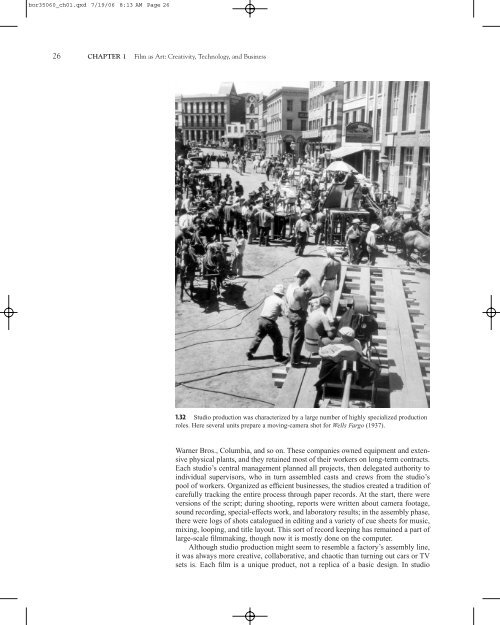FILM ART AND FILMMAKING
FILM ART AND FILMMAKING
FILM ART AND FILMMAKING
You also want an ePaper? Increase the reach of your titles
YUMPU automatically turns print PDFs into web optimized ePapers that Google loves.
or35060_ch01.qxd 7/19/06 8:13 AM Page 26<br />
26 CHAPTER 1 Film as Art: Creativity, Technology, and Business<br />
1.32 Studio production was characterized by a large number of highly specialized production<br />
roles. Here several units prepare a moving-camera shot for Wells Fargo (1937).<br />
Warner Bros., Columbia, and so on. These companies owned equipment and extensive<br />
physical plants, and they retained most of their workers on long-term contracts.<br />
Each studio’s central management planned all projects, then delegated authority to<br />
individual supervisors, who in turn assembled casts and crews from the studio’s<br />
pool of workers. Organized as efficient businesses, the studios created a tradition of<br />
carefully tracking the entire process through paper records. At the start, there were<br />
versions of the script; during shooting, reports were written about camera footage,<br />
sound recording, special-effects work, and laboratory results; in the assembly phase,<br />
there were logs of shots catalogued in editing and a variety of cue sheets for music,<br />
mixing, looping, and title layout. This sort of record keeping has remained a part of<br />
large-scale filmmaking, though now it is mostly done on the computer.<br />
Although studio production might seem to resemble a factory’s assembly line,<br />
it was always more creative, collaborative, and chaotic than turning out cars or TV<br />
sets is. Each film is a unique product, not a replica of a basic design. In studio

















